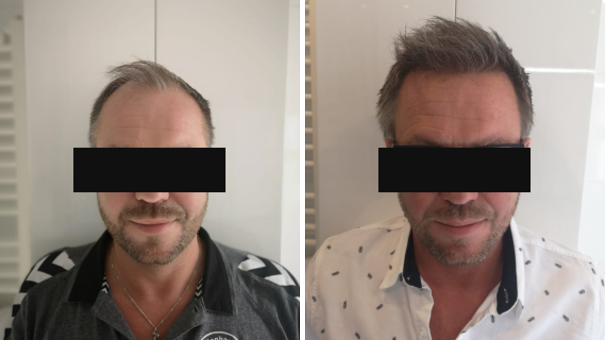Sapphire FUE vs. Classic FUE: Which Is Best?
Innovation within the hair transplant industry is growing every day. Since it’s first mention back in 1939, new ideas and technologies have paved the way for increasingly effective treatment.
One of the most prominent examples in recent years has been the development of sapphire FUE hair transplant. A take on the already popular follicular unit extraction (FUE) method, the sapphire FUE technique focuses on the channel opening stage of the treatment, through the use of specialist sapphire — rather than steel — blades.
But, how does this work exactly, how does it compare to classic FUE, and what benefits can it bring? Below, we’ve looked into this in more detail, outlining both methods, as well as examining some of the standout advantages of sapphire FUE.
Find the Right Hair Transplant Specialist at a Fraction of the Cost
Qunomedical only lists hair transplant clinics and doctors that have been thoroughly vetted with quality and affordability in mind. Contact us for your 100% free, non-binding assessment.
A Quick Recap: What Is FUE and How Does It Work?
Follicular unit extraction (FUE) is the most popular and widely-used hair transplantation method. Simply put, the technique involves the extraction and transplantation of individual follicular units, which contain around 1-4 hairs, from one part of the body to another. Most commonly, this means extracting hair follicles from the back or sides of the head — where there’s still good density — and transplanting them to the balding area on the top of the head.
Follicular units that are taken from the back or sides of the head, known as the donor area, are thought to be resistant to a hormone called dihydrotestosterone (DHT) — believed to be responsible for causing hair loss. Once transplanted to the top of the head, also known as the recipient area, these hair follicles retain their resistance to DHT, preventing them from falling out in the future. It’s for this reason, that hair transplantation surgery is considered to be a long-lasting procedure, however, longevity can vary from patient to patient depending on individual circumstances.
A key stage of the procedure is the creation of what are known as channels. Essentially, these are small incisions that are made in the recipient area in which the extracted follicular units are then implanted into. These channels help to determine the angle, direction, and density of the new hair growth following treatment. Follicular units are inserted into them individually to create the most natural-looking results.
What Is Sapphire FUE Hair Transplant?
Despite its high levels of success, the classic FUE method is constantly developing around new innovative ideas and technologies. In recent years, it took a step forward with the introduction of what’s become known as sapphire FUE. This is not a completely new technique however, rather, it’s a development of the existing FUE method.
A sapphire hair transplant is carried out in much the same way as an ordinary FUE transplant. The difference between the two comes down to the blade that’s used during the channel creation stage. While the classic FUE method uses steel blades for this process, the sapphire hair transplant technique, as the name suggests, is carried out using sapphire blades. Made from precious gemstone, sapphire blades are known for their sharpness, smoothness, and durability. It’s these properties that allow the surgeon to create what are known as micro-channels — essentially smaller, more accurate incisions in the recipient area.
This is important as the creation of channels is the most important stage of a hair transplantation surgery. As mentioned, the nature of these created channels is what plays a role in determining the density, angle, and direction of the new hair growth following the procedure. Having the ability to create smaller and more precise channels using a sapphire blade can produce more natural-looking results than are possible to achieve with a conventional steel blade.
What Are the Advantages of a Sapphire FUE Hair Transplant?
The introduction of sapphire blades to the FUE hair transplant technique in 2016 helped to revolutionise the potential of the treatment. There are a number of key benefits associated with sapphire FUE and we’ve outlined these in more detail below.
1. A Lower Risk of Post-Op Complications
Although the occurrence of postoperative complications are fairly low following a standard FUE hair transplant, the sapphire FUE technique lowers this risk even further. Conventional steel blades used in classic FUE surgeries become blunt and less efficient over time, which can cause tissue damage during the channel creation stage. Sapphire blades on the other hand, are much sharper to begin with, and are able to retain their sharpness for longer. This reduces the risk of tissue becoming damaged during the creation of the channels, while also helping to minimise scab formation. A sapphire blade also contains antimicrobial and antibacterial properties, which helps to reduce the risk of infection during the surgery.
2. Natural-Looking Results
FUE is renowned for the natural-looking results that it’s able to produce. However, sapphire FUE has taken this one step further. Thanks to the versatility of a sapphire blade, the surgeon is able to create more accurate and precise micro-channels. The transplanted follicular units can then be placed at natural angles and directions, creating a more seamless look overall. Following surgery, the new hair will continue to grow in the angles and directions set by the micro-channels, allowing for an extremely natural-looking result.
3. Increased Density
The development of sapphire FUE has opened up the treatment to a number of individuals who would’ve otherwise been ineligible. Due to the smaller shape — and sharper tip — of the sapphire blade, surgeons are able to create more micro-channels in the recipient area. Essentially, this allows for transplanted follicular units to be placed closer together, eventually creating more density as the hair growth kicks in. This has significantly increased the potential of seeing a successful hair transplantation for individuals who experience advanced hair loss.
4. Retaining Hair Follicles
Since a sapphire blade is smaller and more precise than a steel blade, surgeons also have the ability to create compact incisions that are the exact length of the hair follicles being transplanted. This reduces the risk of the transplanted follicles moving around, changing angle, or becoming dislodged following the surgery.
5. Suitable for Metal Sensitivities
While this may only apply to a small portion of hair transplant candidates, it’s an important benefit of sapphire FUE. Sapphire blades are suitable for use on those who are allergic to nickel, steel, or any other kind of metal material. This has allowed hair transplantation surgery to become a viable option for a number of individuals who would’ve otherwise been unable to undergo the treatment.

Sapphire FUE hair transplant before and after at Smile Hair Clinic.
Innovative Alternatives: Diamond FUE
It’s not only the sapphire FUE technique that has been revolutionising the hair transplant industry. A second innovative method, known as diamond FUE, also offers more precision and accuracy when it comes to carrying out the procedure. As the name suggests, this method is performed using specialist diamond blades. Due to the natural solid structure of the diamond gemstone, diamond blades offer surgeons even more precision, allowing them to make smaller and more accurate incisions during the channel creation stage. Similarly to sapphire blades, diamond blades also have antibacterial properties and can produce more natural-looking results than conventional steel blades.
Diamond and Sapphire FUE: Popular Clinics and Doctors
A range of high-quality clinics around the world attract many international patients for a sapphire FUE hair transplant, Turkey being one of the most popular destinations. Home to a combination of renowned specialists, state-of-the-art facilities, and more affordable prices compared to other European countries, it’s not difficult to see why Turkey is such a popular hotspot for hair transplantation surgery.
Highly experienced hair transplant surgeon Dr. Ziya Yavuz is one of Turkey's most prominent specialists performing the sapphire hair transplant method. Practicing since 2005, Dr. Yavuz offers sapphire FUE packages tailored specifically to international patients, with airport pick-up, accommodation, and clinic transfers all included in the overall price.
For those interested in undergoing the diamond FUE method, high-quality, affordable options can also be found by travelling abroad. One of the most reputable clinics offering the treatment is the First Hair Clinic in Frankfurt am Main, Germany. Located in the heart of Europe’s financial capital, First Hair is renowned for its combination of state-of-the-art techniques, highly-experienced doctors and technicians, and competitive prices. If you are looking for a hair specialist in the capital, Dr Al Shehab is a great choice. He has been practicing since 2010 and works at Novohair Clinic in Berlin.
We'll Start You on Your Own Sapphire Hair Transplant Journey
Looking for more information on sapphire FUE? Ready to move forward to find the right doctor or clinic for your own sapphire hair transplant? We’re here to help! Get in touch with us and one of our Patient Managers will be there to assist you. We offer a 100% free, non-binding assessment, regardless of whether you decide to book or not. If you do decide to move forward with treatment, we’ll be with you every step of the way, from initial consultations, through to post-operative support.

Patient manager
Frieda
Your personal Patient Manager
Let's talk
Still unsure? Feeling overwhelmed? Talking to a real person can give you the guidance and reassurance needed. You don’t have to do it alone. Let’s find the right doctor together.
